I’m kind of a nut when it comes to organization and planning, and it may border on overkill. Sometimes I think I may spend more time with this than I do in the garden. I do most of this organization work during the winter when I have the extra time on my hands. When garden time comes, all I need to do is minor updates & notes. My methods for organizing and planning are not specific to high-altitude gardening, but are extra helpful when planning a garden that only grows in a short season, or for making full use of limited space in the greenhouse year-round.
SEED SELECTION
When I begin the process of seed selection for the year, I begin an Excel spreadsheet. Mine looks something like this. I start this process in January, and get seeds ordered in February, before the varieties I’ve chosen are no longer available (which has happened before).

I begin by deciding what types of plants I plan to grow, and make a list. The first 3 columns show whether I will grow them in the greenhouse, the cold frame or the outside garden. Then I begin looking at various websites and books that I have, to determine what varieties I might like. I add notes about whether they are organic, how many days to harvest, the vendor, price and miscellaneous notes about the varieties. I start with a BIG list, then begin to delete those I decide not to order. Eventually my list looks something like the one above, which I can sort by vendor, then go to that website and use this as my order list. The varieties with blank spaces indicate seeds I already have on hand.
KEEPING NOTES
After this, I have plenty of time to add information about all these seeds to my notebooks, and to look up information regarding when to plant the seeds, whether to start them indoors or in the garden, etc.
For this process, I use Microsoft One Note. I prefer the Microsoft Office desktop version, but it is also available as a free app, available for Windows or Apple operating systems, or online with any browser. I use this extensively for all my garden planning and note-taking.

These are the main sections (Tabs) I use:
- PLANNING: links to websites I refer to, companion planting information, seed companies, etc.
- BEDS: information about what treatments have been given to each bed in my garden
- GREENHOUSE: general planning information for the greenhouse
- HI-ALTITUDE: various information about high-altitude gardening, my weather and frost date information, best types of vegetables for high-altitude, etc.
- FUTURE: ideas to explore in the future
- NATURE: I keep logs of when I view various birds, squirrels, deer, elk, antelope, various wildflowers, etc.
- PESTS: pests I see, what I do about them, information about pest control
- SOIL & AMENDMENTS: information about fertilizers, soil amendments, etc.
-
PLANTS: This is a group section with sub-sections including: Alliums, Beans, Beets, Brassicas, Carrots….you get the idea.
- Each of these sections contain pages of what I’m planting, including all the varieties I’m planting, dates started, transplanted, harvested, days to harvest, notes about how they did, etc. I also include growing information here.
Here’s a look at my “Brassica” section (under the “PLANTS” group) as an example, showing the page of 2017 Greenhouse Brassicas:

This year I’ve made a separate One Note Notebook, I call “Guffey Veggies”. I used to keep all this information in one notebook, but it got too full of stuff and hard to organize. Now I’m using this “Guffey Veggies” notebook to keep notes on all the seeds I choose. Since I order most of my seeds online, it’s easy to copy and paste this information into the notebook for future reference. Those pages look something like this:

PLANNING & PLANTING
One more thing I did this year was to create a spreadsheet to help me know when to start each vegetable for the greenhouse, the cold frame and the outside garden. It looks like this:

Let me explain this!
- WHERE: Greenhouse, Cold Frame, or Outside
- SPECIES, VARIETY: vegetable to plant
- DAYS: Days to maturity
- HOW: whether I will start this inside in soil blocks, or direct-sow outside
- START: the day I will start the seeds. This is automatically calculated from the columns that show when I plan to transplant out, and the number of weeks/days the plant will remain inside before planting.
- WEEKS INSIDE, DAYS TO TRANSPLANT: weeks, days from sowing to transplanting out.
- TRANSPLANT OR START OUTSIDE: gathered from growing information I’ve collected
- OUT ETA: The date I plan to transplant or sow outside
- HARVEST ETA: This is the date transplanted out + the number of days to harvest.
- 2018 ACTUAL HARVEST: to be filled in as the summer progresses
This spreadsheet can be sorted as desired: by coldframe, greenhouse, outside, by start date, etc. Right now I’m finding it most handy to sort by start date, so I know what I need to be doing in the coming weeks. As you can see, I’m planning to plant outside in the coldframe sometime around May 15. This will depend on the weather—some things may go out sooner or later than the 15th.
Hopefully all of this is helpful to anyone reading. Everyone has their own way of doing things, and others may do just fine without all this time-consuming organization. If you just “wing it” you may be just as successful, but I find it helpful to do all of this and keep track of what I’m doing so I can go back the next year to determine what worked and what didn’t.
For instance, last year I started my fall plantings of beets, cabbages, broccoli and a few other things too late. They just didn’t have time to grow before fall. I also found that starting most things in the ground last year wasn’t successful. I am glad to have all of these dates & information written down from last year. This year I will start almost everything indoors and plan to transplant them out after they’ve sprouted and gained a little growth. (I will still start carrots & peas outside, but that’s about it.) I know that in my cool weather, the harvest dates for almost everything will be later than expected, but I used the published “Date to Harvest” anyway. I will compare this with my actual harvest dates.


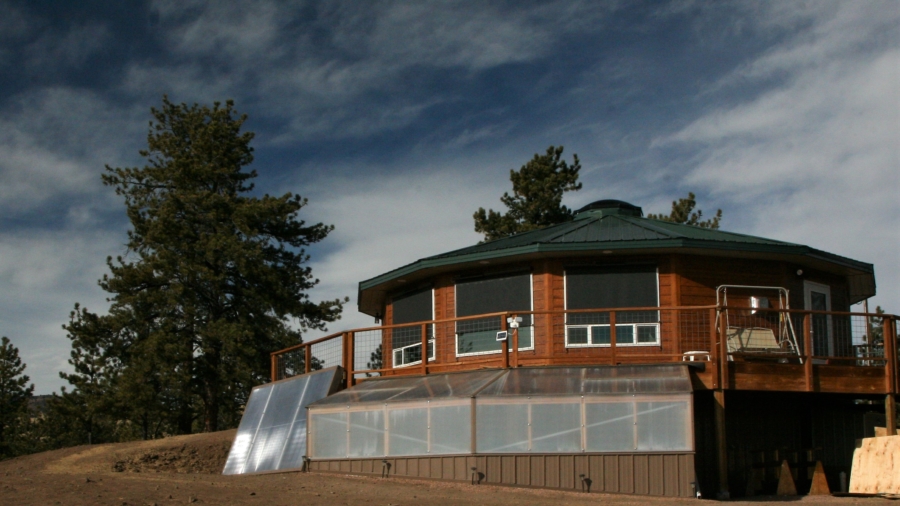




 Since our first successful winters with the greenhouse, we have since made some improvements to the heating system. The concrete floor, the soil and the pond (which holds about 200 gallons of water) all provide thermal mass storage. When the greenhouse was planned and built, we installed radiant in-floor heating, to be heated with water from our solar collector. Over time, we determined that this was not necessary. The concrete floor and the soil beds stay plenty warm without the in-floor heat, but what needs more warmth overnight and on the coldest days is the air. This past year Tim purchased and installed a used wall heater which uses the hot water from our solar collector as its heat source. This has worked quite well to keep the greenhouse warm overnight most nights, and we have an electric space heater to add additional warmth on the coldest of nights, when it has been too cloudy to heat enough water with the sun. Tim has these all set on with thermostat sensors and computer programs that turn everything on and off as needed. Good to have a geeky guy around! We also no longer put up the insulation over the glazing each night, which was labor-intensive and not all that helpful.
Since our first successful winters with the greenhouse, we have since made some improvements to the heating system. The concrete floor, the soil and the pond (which holds about 200 gallons of water) all provide thermal mass storage. When the greenhouse was planned and built, we installed radiant in-floor heating, to be heated with water from our solar collector. Over time, we determined that this was not necessary. The concrete floor and the soil beds stay plenty warm without the in-floor heat, but what needs more warmth overnight and on the coldest days is the air. This past year Tim purchased and installed a used wall heater which uses the hot water from our solar collector as its heat source. This has worked quite well to keep the greenhouse warm overnight most nights, and we have an electric space heater to add additional warmth on the coldest of nights, when it has been too cloudy to heat enough water with the sun. Tim has these all set on with thermostat sensors and computer programs that turn everything on and off as needed. Good to have a geeky guy around! We also no longer put up the insulation over the glazing each night, which was labor-intensive and not all that helpful. 





 In general, almost everything took longer to reach maturity than expected. For instance, I picked the very first, 55-day tomato on day 74. I finally harvested the “100 day” onions, even though they could have had more growth, on about day 150 and later. Since the tops never really fell over on their own, they’re not curing properly, and they won’t last long in storage. Many other things took a lot longer than expected as well. I will detail those along with my observation of each vegetable family.
In general, almost everything took longer to reach maturity than expected. For instance, I picked the very first, 55-day tomato on day 74. I finally harvested the “100 day” onions, even though they could have had more growth, on about day 150 and later. Since the tops never really fell over on their own, they’re not curing properly, and they won’t last long in storage. Many other things took a lot longer than expected as well. I will detail those along with my observation of each vegetable family.



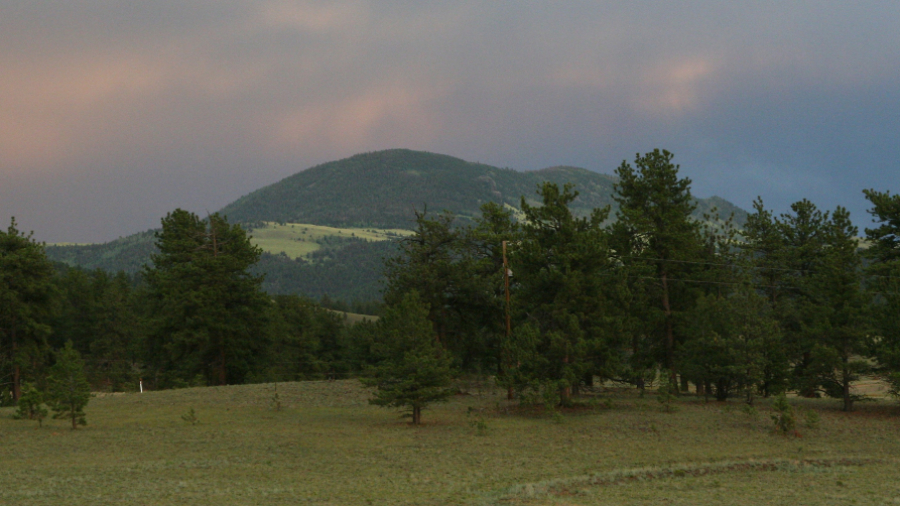









 At least, we haven’t seen evidence of them burrowing through it. Our second line of defense against these guys will be a layer of stucco netting, which is a LOT cheaper than the hardware cloth which is often recommended as protection from ground squirrels. Any long roots should still be able to penetrate both the stucco netting and the rocky bottom. Additionally, just to the inside of the perimeter beds, there will be a layer of plastic lining the walkway, to keep both the weeds and the squirrels out.
At least, we haven’t seen evidence of them burrowing through it. Our second line of defense against these guys will be a layer of stucco netting, which is a LOT cheaper than the hardware cloth which is often recommended as protection from ground squirrels. Any long roots should still be able to penetrate both the stucco netting and the rocky bottom. Additionally, just to the inside of the perimeter beds, there will be a layer of plastic lining the walkway, to keep both the weeds and the squirrels out. This is a shot of the garden site, the morning of April 19, 2017. Although we have 40 acres, most of which is pretty flat with no trees, we are placing the garden here, in a protected spot from wind, and where plants may get a little shade in the afternoons. The area gets full sun from the E-SE all morning into early afternoon. We feel this site will be best, to protect them from the full effect of the intense sun at our elevation. It is also relatively close to the water hydrant. Tim has begun clearing the area and is building the raised beds. The garden itself will be 41 x 35 feet in size, a little over 1400 square feet. The actual planting bed space will be 740 square feet. There is some slope on this site, so it will be terraced a bit along that slope. The entrance to the garden will be wide enough for the tractor to fit through, which has been and will continue to be a big help. The beds will be filled with a soil combination of natural soil, well-aged horse manure, used duck bedding, some additional organic matter and compost.
This is a shot of the garden site, the morning of April 19, 2017. Although we have 40 acres, most of which is pretty flat with no trees, we are placing the garden here, in a protected spot from wind, and where plants may get a little shade in the afternoons. The area gets full sun from the E-SE all morning into early afternoon. We feel this site will be best, to protect them from the full effect of the intense sun at our elevation. It is also relatively close to the water hydrant. Tim has begun clearing the area and is building the raised beds. The garden itself will be 41 x 35 feet in size, a little over 1400 square feet. The actual planting bed space will be 740 square feet. There is some slope on this site, so it will be terraced a bit along that slope. The entrance to the garden will be wide enough for the tractor to fit through, which has been and will continue to be a big help. The beds will be filled with a soil combination of natural soil, well-aged horse manure, used duck bedding, some additional organic matter and compost.
 In addition to planning the physical garden, Tim has put together a potting bench area and grow lights under the house in our crawl space. It’s not real pretty down there, but functional. The sink and potting area are helpful for me to mix and prepare the soil blocks I use to start seedlings. Under these lights, I already have started several things; mostly greens for the cold frame section which will be planted mid-May, onions and a few other things which take a long time to get started. The lights can be raised as the plants grow. If necessary, we have more lights that can be placed on the lower side of this bench. (See more about my soil block approach
In addition to planning the physical garden, Tim has put together a potting bench area and grow lights under the house in our crawl space. It’s not real pretty down there, but functional. The sink and potting area are helpful for me to mix and prepare the soil blocks I use to start seedlings. Under these lights, I already have started several things; mostly greens for the cold frame section which will be planted mid-May, onions and a few other things which take a long time to get started. The lights can be raised as the plants grow. If necessary, we have more lights that can be placed on the lower side of this bench. (See more about my soil block approach 
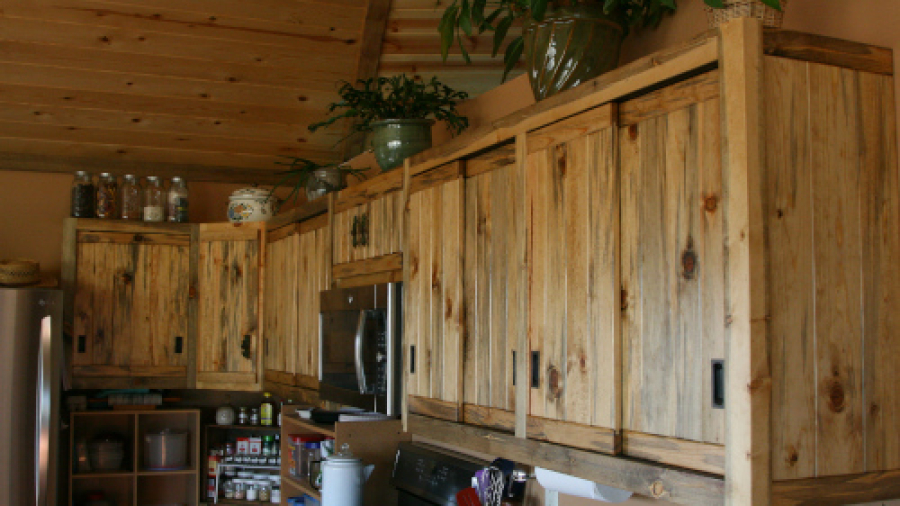
 After functioning quite well with our temporary kitchen, we’re finally getting around to making the custom kitchen that we have envisioned for so long. Before that could begin, however, I had to get my workshop in good working order. This included adding heat so I could work regardless of the weather, purchasing some vitally needed tools for making the cabinets (yes, they really were necessary) and spending some time implementing good dust collection. There is a lot of sawdust generated in woodworking and now is not the time to ignore good health and safety practices. So, now that the shop is in pretty good shape … let the cabinet making begin!
After functioning quite well with our temporary kitchen, we’re finally getting around to making the custom kitchen that we have envisioned for so long. Before that could begin, however, I had to get my workshop in good working order. This included adding heat so I could work regardless of the weather, purchasing some vitally needed tools for making the cabinets (yes, they really were necessary) and spending some time implementing good dust collection. There is a lot of sawdust generated in woodworking and now is not the time to ignore good health and safety practices. So, now that the shop is in pretty good shape … let the cabinet making begin!
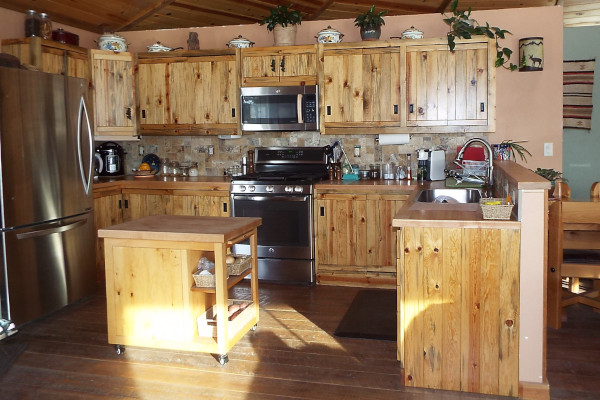


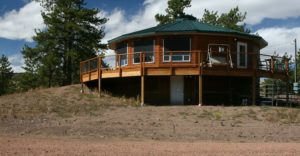
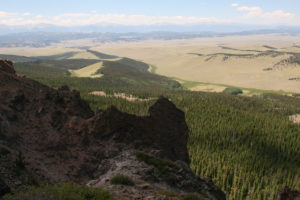
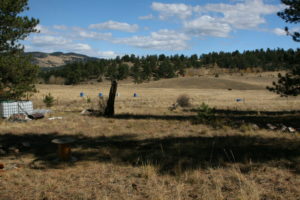 Here’s where the garden will go. This photo was taken
Here’s where the garden will go. This photo was taken 
